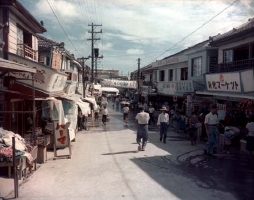Naha
the Capital City
Naha,
the island's largest city lies on the southern part of the Island.
It is the political, economic and traffic center of the island.
1950s
 |
 |
|
Shown above is the capital city of Naha as seen in 1955. I was there a few times, but, we mainly shopped in the markets of small villages closer to where we lived. Within tiny cubicles under a tin-roofed structure, the men and women sat upon tatami mats on the floor, surrounded by their wares. These were the poor, post- WWII years. Everyone in a family might be selling something to support their family. I had most of my clothes tailored by seamtresses there. The seamstresses could copy anything I showed them from an American magazine, such as Seventeen. Sometimes, I designed my own clothes, adapting some of the traditional island materials and designs. The island is still known today for its beautiful fabrics, created by traditional techniques unique to the island. There was anything and everything for sale in the adjoining stalls! Dried sea snakes hung in the rafters, along with many other exotic items. The melange of aromas of all sorts have never left my memory to this day. I would recognize them anywhere! |
 |
Modern
Naha!
|
Kokusai-dori
(International Street) is the most crowded place in Naha. The
street is called "the one-mile miracle" because it is the center
of the island's reconstruction after World War II. About 1.6 kilometers
long, it is now lined with department stores, shops, movie theaters,
restaurants and coffee shops and
the Makishi Public Market.
|
 |
 |
 |
 |
 |
 |
 |
 |
 |
 |
 |
 |
 |
 |
 |
 |
 |
 |
The
islanders' diet is based on fish, seafood, pork and local fruits and
vegetables.
This includes seasnakes (shown right end of the next-to-last row).
Rice wines and an alcoholic beverage called Awamori are also shown 3rd
row above.
|
The
island has its own unique culture...
Its people have their own distinctive music, their own unique language, and their own steadfast traditions which began centuries ago when the island was the Ryukyu Kingdom, the Island Kingdom. From the late 1300s and for the next 400 years, Ryukyu was its own nation, ruled by royalty. It was a prosperous time when trade flourished with China, Japan, Korea and the East Indies. It was a time when peace and stability were embraced. On the following pages, you will find some of the unique aspects of the island culture and its traditions. |
Continued...
The People, Costumes,
Festivals,
Traditional Arts & Crafts and Architecture...
Click here